Comparative Analysis of Intra- and Inter-Specific Genomic Variability in the Peach Potato Aphid, Myzus persicae
Abstract
:1. Introduction
2. Materials and Methods
3. Results
4. Discussion
5. Conclusions
Supplementary Materials
Author Contributions
Funding
Acknowledgments
Conflicts of Interest
References
- Honeybee Genome Sequencing Consortium. Insights into social insects from the genome of the honey bee. Nature 2006, 443, 931–949. [Google Scholar] [CrossRef] [PubMed]
- Grimmelikhuijzen, C.J.; Cazzamali, G.; Williamson, M.; Hauser, F. The promise of insect genomics. Pestic. Manag. Sci. 2007, 63, 413–416. [Google Scholar] [CrossRef] [PubMed]
- Tribolium Genome Sequencing Consortium. The genome of the model beetle and pest Tribolium castaneum. Nature 2008, 452, 949–955. [Google Scholar] [CrossRef] [PubMed]
- Arensburger, P.; Megy, K.; Waterhouse, R.M.; Abrudan, J.; Amedeo, P.; Antelo, B.; Bartholomay, L.; Bidwell, S.; Caler, E.; Camara, F.; et al. Sequencing of Culex quinquefasciatus establishes a platform for mosquito comparative genomics. Science 2010, 330, 86–88. [Google Scholar] [CrossRef]
- Chilana, P.; Sharma, A.; Rai, A. Insect genomic resources: Status, availability and future. Curr. Sci. 2012, 102, 571–580. [Google Scholar]
- Mesquita, R.D.; Vionette-Amaral, R.J.; Lowenberger, C.; Rivera-Pomar, R.; Monteiro, F.A.; Minx, P.; Spieth, J.; Carvalho, A.B.; Panzera, F.; Lawson, D.; et al. Genome of Rhodnius prolixus, an insect vector of Chagas disease, reveals unique adaptations to hematophagy and parasite infection. Proc. Natl. Acad. Sci. USA 2015, 112, 14936–14941. [Google Scholar] [CrossRef]
- Dudchenko, O.; Batra, S.S.; Omer, A.D.; Nyquist, S.K.; Hoeger, M.; Durand, N.C.; Shamim, M.S.; Machol, I.; Lander, E.S.; Aiden, A.P.; et al. De novo assembly of the Aedes aegypti genome using Hi-C yields chromosome-length scaffolds. Science 2017, 356, 92–95. [Google Scholar] [CrossRef]
- International Aphid Genomics Consortium. Genome sequence of the pea aphid Acyrthosiphon pisum. PLoS Biol. 2010, 8, e1000313. [Google Scholar] [CrossRef]
- Nicholson, S.J.; Nickerson, M.L.; Dean, M.; Song, Y.; Hoyt, P.R.; Rhee, H.; Kim, C.; Puterka, G.J. The genome of Diuraphis noxia, a global aphid pest of small grains. BMC Genom. 2015, 16, 429. [Google Scholar] [CrossRef]
- Wenger, J.A.; Cassone, B.J.; Legeai, F.; Johnston, J.S.; Bansal, R.; Yates, A.D.; Coates, B.S.; Pavinato, V.A.; Michel, A. Whole genome sequence of the soybean aphid, Aphis glycines. Insect Biochem. Mol. Biol. 2017, in press. [Google Scholar] [CrossRef]
- Quan, Q.; Hu, X.; Pan, B.; Zeng, B.; Wu, N.; Fang, G.; Cao, Y.; Chen, X.; Huang, Y.; Zhan, S. Draft genome of the cotton aphid Aphis gossypii. Insect Biochem. Mol. Biol. 2019, 105, 25–32. [Google Scholar] [CrossRef] [PubMed]
- Tagu, D.; Dugravot, S.; Outreman, Y.; Rispe, C.; Simon, J.C.; Colella, S. The anatomy of an aphid genome: From sequence to biology. C. R. Biol. 2010, 333, 464–473. [Google Scholar] [CrossRef] [PubMed]
- Jaquiéry, J.; Peccoud, J.; Ouisse, T.; Legeai, F.; Prunier-Leterme, N.; Gouin, A.; Nouhaud, P.; Brisson, J.A.; Bickel, R.; Purandare, S.; et al. Disentangling the causes for faster-X evolution in aphids. Genome Biol. Evol. 2018, 10, 507–520. [Google Scholar] [CrossRef] [PubMed]
- Salzberg, S.L.; Church, D.; Di Cuccio, M.; Yaschenko, E.; Ostell, J. The genome assembly archive: A new public resource. PLoS Biol. 2004, 2, e285. [Google Scholar] [CrossRef] [PubMed]
- Muggli, M.D.; Puglisi, S.J.; Ronen, R.; Boucher, C. Misassembly detection using paired-end sequence reads and optical mapping data. Bioinformatics 2015, 31, i80–i88. [Google Scholar] [CrossRef] [Green Version]
- Tang, H.; Bomhoff, M.D.; Briones, E.; Zhang, L.; Schnablw, J.C.; Lyon, E. SynFind: Compiling syntenic regions across any set of genomes on demand. Genome Biol. Evol. 2015, 7, 3286–3298. [Google Scholar] [CrossRef]
- Lyons, E.; Pedersen, B.; Kane, J.; Freeling, M. The value of non-model genomes and an example using SynMap within CoGe to dissect the hexaploidy that predates rosids. Trop. Plant Biol. 2008, 1, 181–190. [Google Scholar] [CrossRef]
- Mandrioli, M.; Zambonini, G.; Manicardi, G.C. Comparative gene mapping as a tool to understand the evolution of pest crop insect chromosomes. Int. J. Mol. Sci. 2017, 18, 1919. [Google Scholar] [CrossRef]
- Untergasser, A.; Cutcutache, I.; Koressaar, T.; Ye, J.; Faircloth, B.C.; Remm, M.; Rozen, S.G. Primer3: new capabilities and interfaces. Nucleic Acids Res. 2012, 40, e115. [Google Scholar] [CrossRef]
- Liebich, I.; Bode, J.; Reuter, I.; Wingender, E. Evaluation of sequence motifs found in scaffold/matrix-attached regions (S/MARs). Nucleic Acids Res. 2002, 30, 3433–3442. [Google Scholar] [CrossRef] [Green Version]
- Lyons, E.; Freeling, M. How to usefully compare homologous plant genes and chromosomes as DNA sequences. Plant J. 2008, 53, 661–673. [Google Scholar] [CrossRef] [PubMed]
- Mandrioli, M.; Borsatti, F. Analysis of heterochromatic epigenetic markers in the holocentric chromosomes of the aphid Acyrthosiphon pisum. Chromosome Res. 2007, 15, 1015–1022. [Google Scholar] [CrossRef] [PubMed]
- Brisson, J.A.; Davis, G.K. Pea Aphid. In Genome Mapping and Genomics in Arthropods; Hunter, W., Kole, C., Eds.; Springer: Berlin/Heidelberg, Germany, 2008; pp. 59–67. [Google Scholar]
- Manicardi, G.C.; Mandrioli, M.; Blackman, R.L. The cytogenetic architecture of the aphid genome. Biol. Rev. 2015, 90, 112–125. [Google Scholar] [CrossRef] [PubMed]
- Manicardi, G.C.; Nardelli, A.; Mandrioli, M. Fast chromosomal evolution and karyotype instability: Occurrence of recurrent chromosomal rearrangements in the peach potato aphid Myzus persicae (Hemiptera, Aphididae). Biol. J. Linn. Soc. 2015, 116, 519–529. [Google Scholar] [CrossRef]
- Mathers, T.C.; Chen, Y.; Kaithakottil, G.; Legeai, F.; Mugford, S.T.; Baa-Puyoulet, P.; Bretaudeau, A.; Clavijo, B.; Colella, S.; Collin, O.; et al. Rapid transcriptional plasticity of duplicated gene clusters enables a clonally reproducing aphid to colonise diverse plant species. Genome Biol. 2017, 18, 27. [Google Scholar] [CrossRef]
- Monti, V.; Giusti, M.; Bizzaro, D.; Manicardi, G.C.; Mandrioli, M. Presence of a functional (TTAGG)n telomere-telomerase system in aphids. Chromosome Res. 2011, 19, 625–633. [Google Scholar] [CrossRef]
- Li, L.; Stoeckert, C.J., Jr.; Roos, D.S. OrthoMCL: Identification of ortholog groups for eukaryotic genomes. Genome Res. 2003, 13, 2178–2189. [Google Scholar] [CrossRef]
- Ostlund, G.; Schmitt, T.; Forslund, K.; Köstler, T.; Messina, D.N.; Roopra, S.; Frings, O.; Sonnhammer, E.L. InParanoid 7: New algorithms and tools for eukaryotic orthology analysis. Nucleic Acids Res. 2010, 38, D196–D203. [Google Scholar] [CrossRef]
- Moreno-Hagelsieb, G.; Trevino, V.; Perez-Rueda, E.; Smith, T.F.; Collado-Vides, J. Transcription unit conservation in the three domains of life: A perspective from Escherichia coli. Trends Genet. 2001, 17, 175–177. [Google Scholar] [CrossRef]
- Poyatos, J.F.; Hurst, L.D. The determinants of gene order conservation in yeasts. Genome Biol. 2007, 8, R233. [Google Scholar] [CrossRef]
- Heger, A.; Ponting, C.P. Evolutionary rate analyses of orthologs and paralogs from 12 Drosophila genomes. Genome Res. 2007, 17, 1837–1849. [Google Scholar] [CrossRef] [PubMed]
- Davidson, R.M.; Gowda, M.; Moghe, G.; Lin, H.; Vaillancourt, B.; Shiu, S.H.; Jiang, N.; Robin Buell, C. Comparative transcriptomics of three Poaceae species reveals patterns of gene expression evolution. Plant J. 2012, 71, 492–502. [Google Scholar] [CrossRef] [PubMed]
- Mandrioli, M.; Melchiori, G.; Panini, M.; Chiesa, O.; Giordano, R.; Mazzoni, E.; Manicardi, G.C. Analysis of the extent of synteny and conservation in the gene order in aphids: A first glimpse from the Aphis glycines genome. Insect Biochem. Mol. Biol. 2019, 113, 103228. [Google Scholar] [CrossRef] [PubMed]
- d’Alençon, E.; Sezutsu, H.; Legeai, F.; Permal, E.; Bernard-Samain, S.; Gimenez, S.; Gagneur, C.; Cousserans, F.; Shimomura, M.; Brun-Barale, A.; et al. Extensive synteny conservation of holocentric chromosomes in Lepidoptera despite high rates of local genome rearrangements. Proc. Natl. Acad. Sci. USA 2010, 107, 7680–7685. [Google Scholar] [CrossRef] [Green Version]
- Lifton, R.P.; Goldberg, M.L.; Karp, R.W.; Hogness, D.S. The organization of the histone genes in Drosophila melanogaster: Functional and evolutionary implications. Cold Spring Harb. Symp. Quant. Biol. 1977, 42, 1047–1051. [Google Scholar] [CrossRef]
- Engel, J.D.; Dodgson, J.B. Histone genes are clustered, but not tandemly repeated in the chicken genome. Proc. Nat. Acad. Sci. USA 1981, 78, 2856–2860. [Google Scholar] [CrossRef]
- Maxon, R.; Cohn, R.; Kedes, L. Expression and organization of histone genes. Annu. Rev. Genet 1983, 17, 239–277. [Google Scholar] [CrossRef]
- Mandrioli, M.; Manicardi, G.C. Chromosomal mapping reveals a dynamic organization of the histone genes in aphids (Hemiptera: Aphididae). Entomologia 2013, 1, e2. [Google Scholar] [CrossRef]
- Roehrdanz, R.; Heilmann, L.; Senechal, P.; Sears, S.; Evenson, P. Histone and ribosomal RNA repetitive gene clusters of the boll weevil are linked in a tandem array. Insect Mol. Biol. 2010, 19, 463–471. [Google Scholar] [CrossRef]
- Strausbaugh, L.D.M.; Weinberg, E.S. Polymorphism and stability in the histone gene cluster of Drosophila melanogaster. Chromosoma 1982, 85, 489–505. [Google Scholar] [CrossRef]
- Loxdale, H.D.; Balog, A.; Harvey, J.A. Generalism in Nature…The great misnomer: Aphids and wasp parasitoids as examples. Insects 2019, 10, 314. [Google Scholar] [CrossRef] [PubMed]
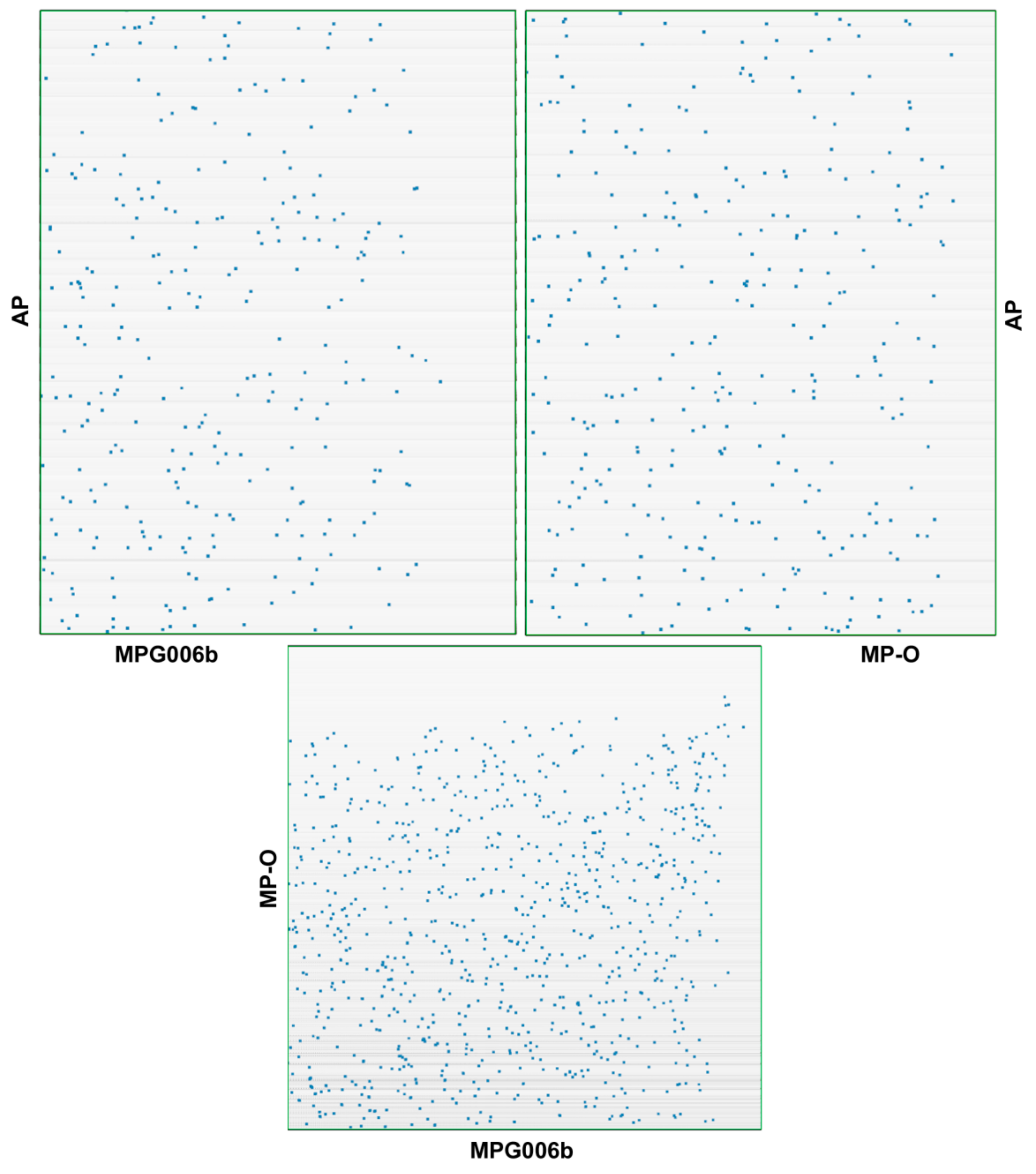
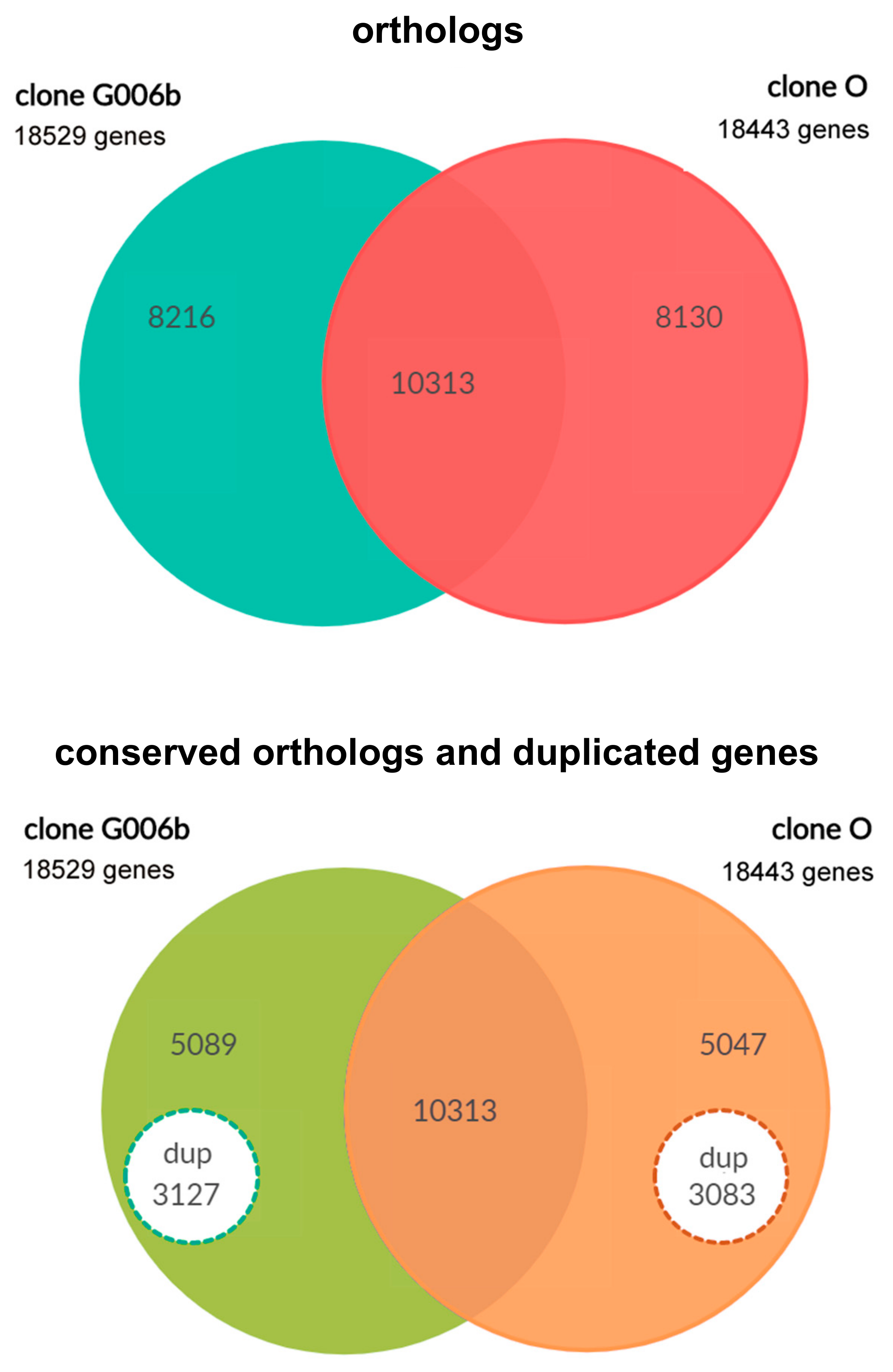
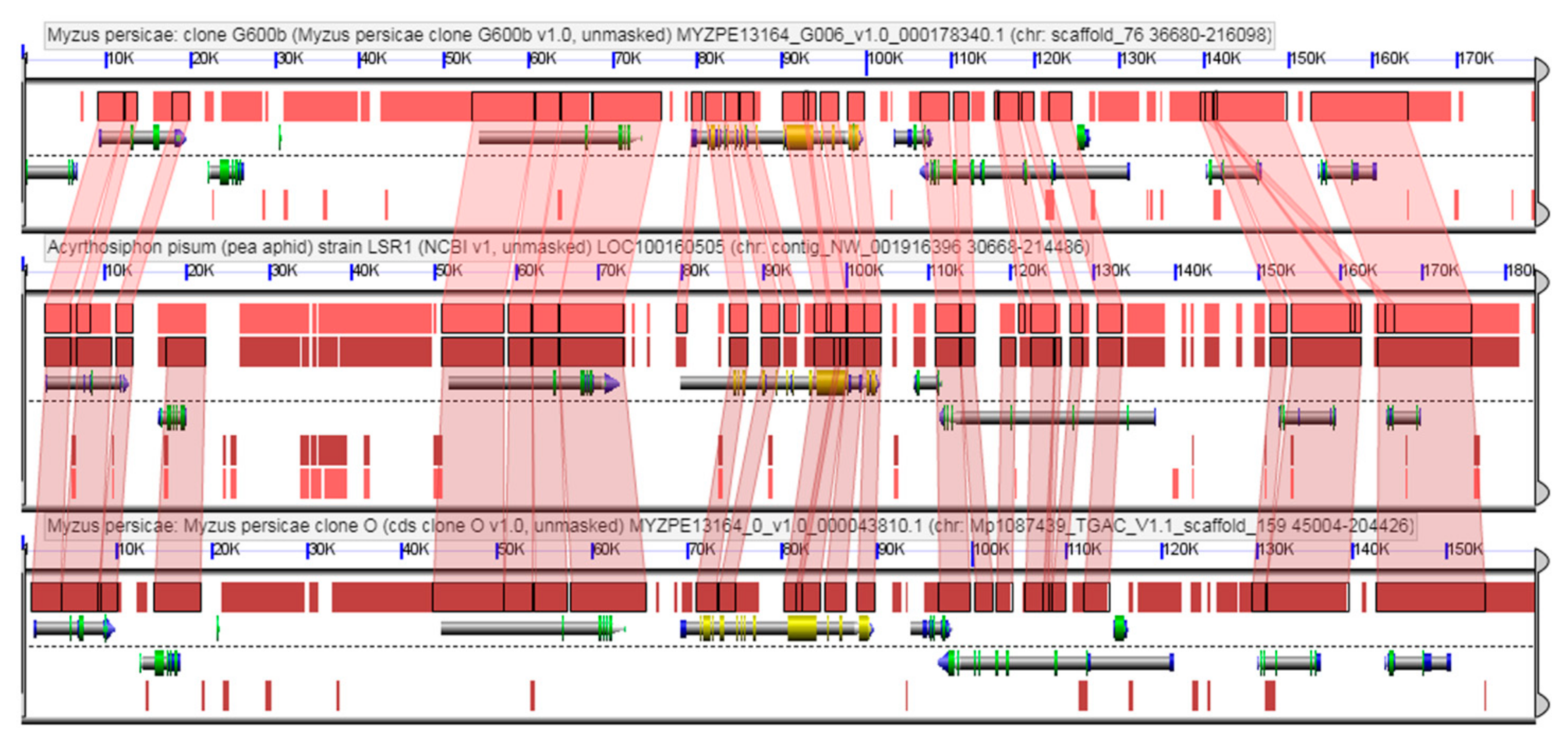
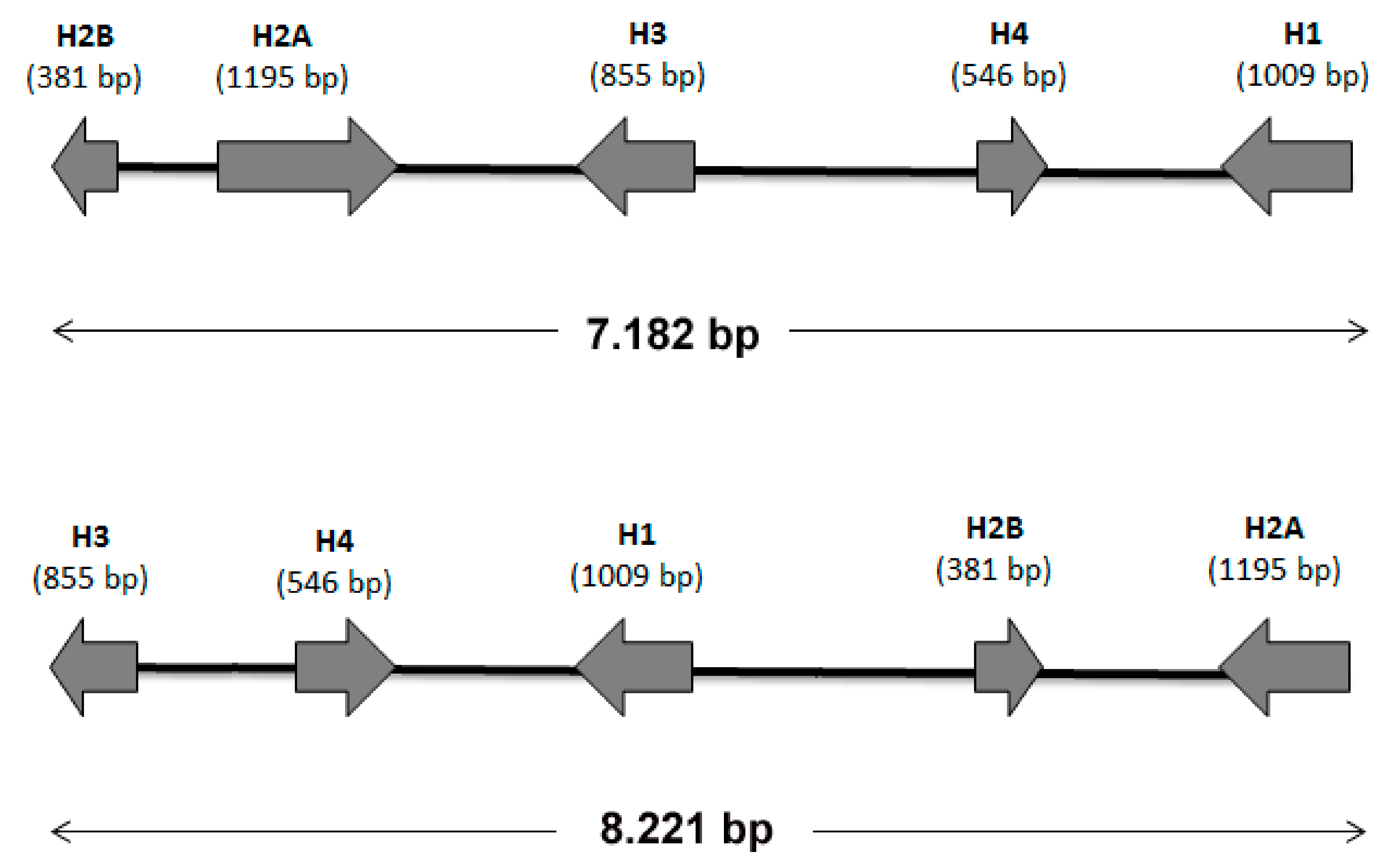
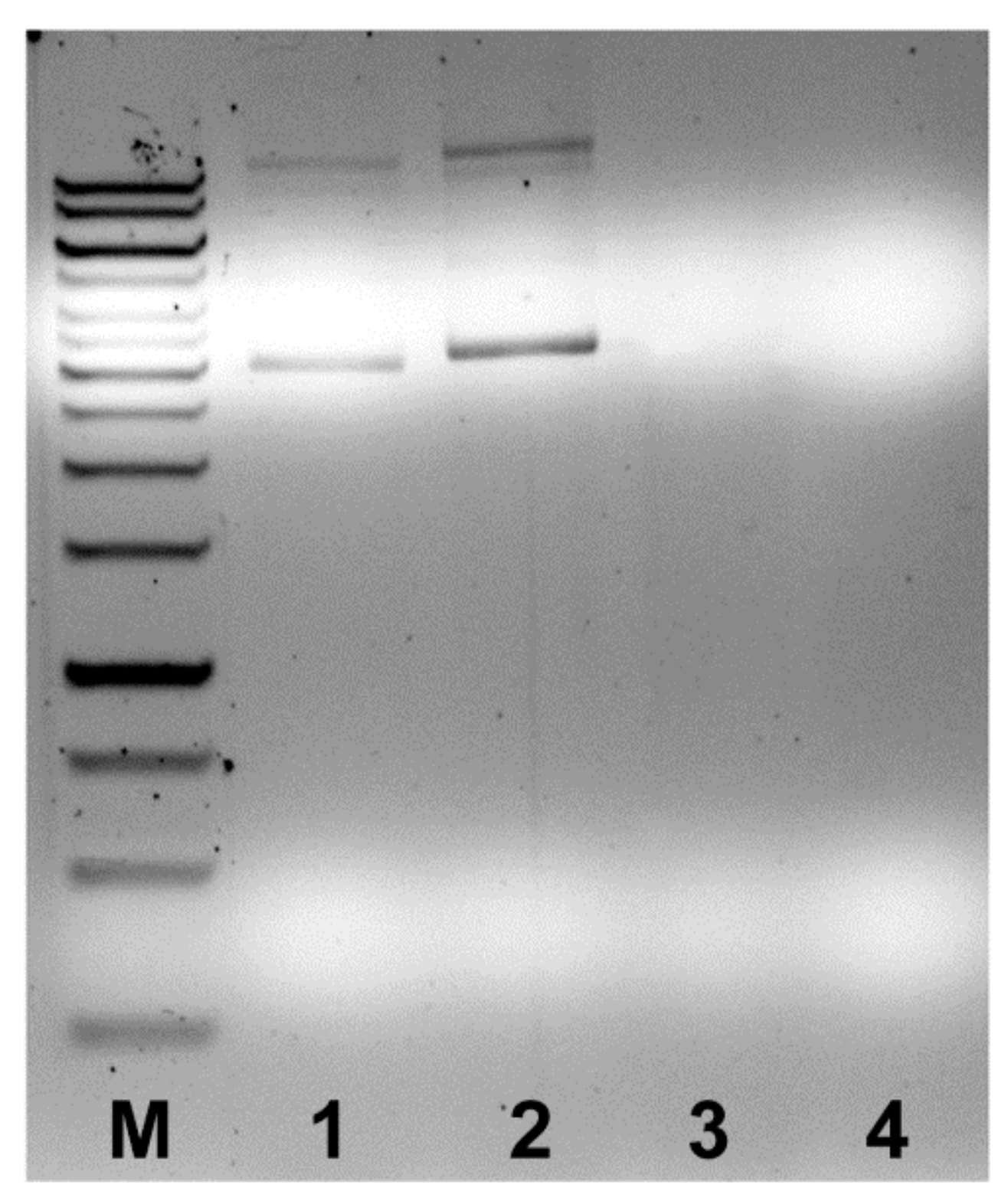
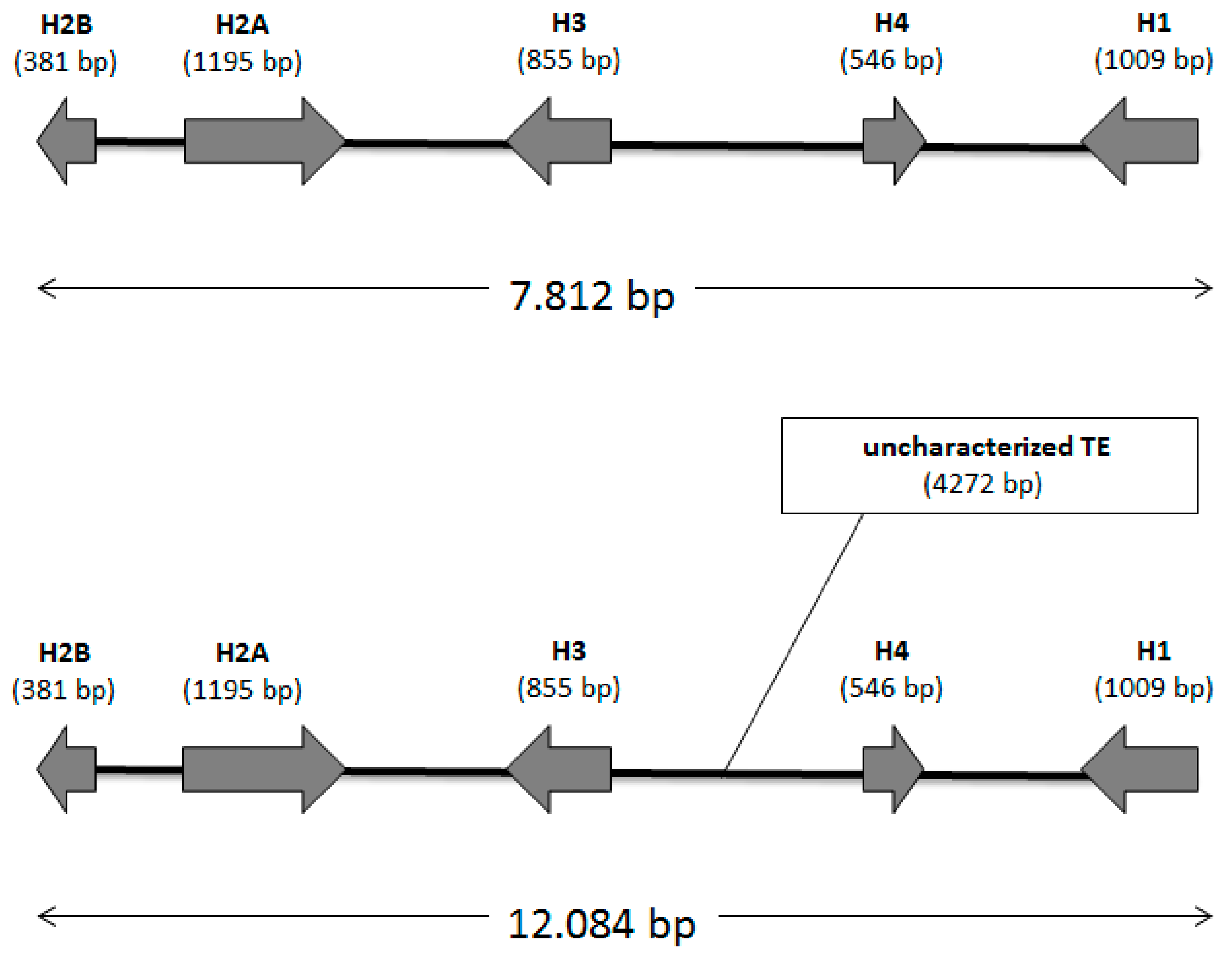

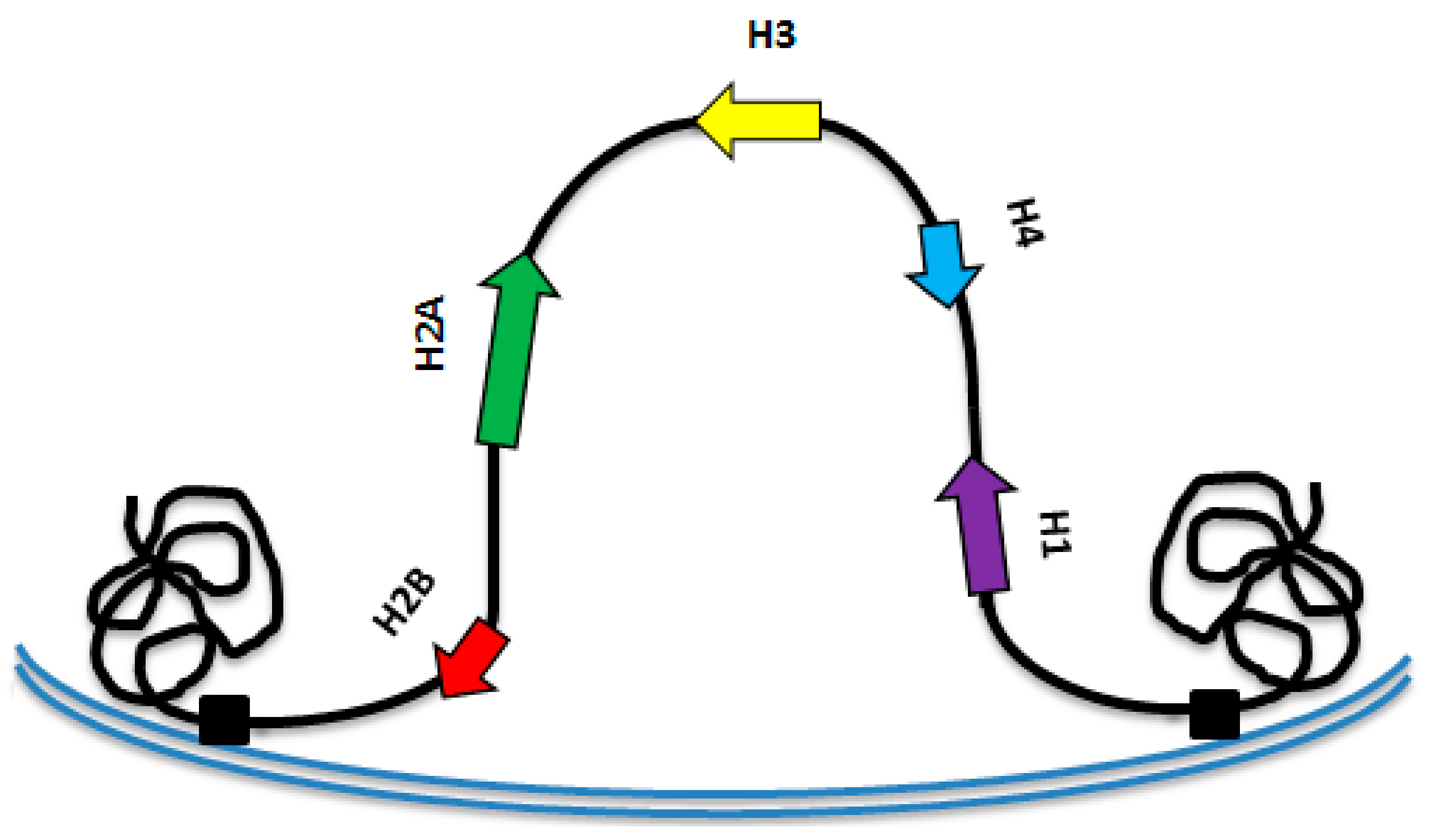
| Primer | Tm (°C) | Sequence (5′- 3′) |
|---|---|---|
| 294_clu-hist_F | 59.93 | ATTTGGAGCTGGTGTACTTGGT |
| 294_clu-histR | 60.52 | TGCAATGCATTATCACAAACG |
| 1711_clu-hist_F | 60.30 | TCGAACAGACCGACCAACTAG |
| 1711_clu-hist_R | 59.83 | TGCAAATGTCTGGGAATGATAC |
| Clone | Address |
|---|---|
| M. persicae clone G006 | https://genomevolution.org/r/15r3b |
| M. persicae clone O | https://genomevolution.org/r/15r40 |
| Syntenic Depth | G006 vs O | O vs G006 |
|---|---|---|
| 0 | 27.37% | 38.50% |
| 1 | 55.86% | 57.19% |
| 2 | 15.38% | 4.32% |
| 3 | 1.34% | 0 |
| 4 | 0.05% | 0 |
© 2019 by the authors. Licensee MDPI, Basel, Switzerland. This article is an open access article distributed under the terms and conditions of the Creative Commons Attribution (CC BY) license (http://creativecommons.org/licenses/by/4.0/).
Share and Cite
Mandrioli, M.; Salvatore, D.; Ferrari, A.; Patelli, N.; Manicardi, G.C. Comparative Analysis of Intra- and Inter-Specific Genomic Variability in the Peach Potato Aphid, Myzus persicae. Insects 2019, 10, 368. https://doi.org/10.3390/insects10100368
Mandrioli M, Salvatore D, Ferrari A, Patelli N, Manicardi GC. Comparative Analysis of Intra- and Inter-Specific Genomic Variability in the Peach Potato Aphid, Myzus persicae. Insects. 2019; 10(10):368. https://doi.org/10.3390/insects10100368
Chicago/Turabian StyleMandrioli, Mauro, Deborah Salvatore, Agnese Ferrari, Niccolò Patelli, and Gian Carlo Manicardi. 2019. "Comparative Analysis of Intra- and Inter-Specific Genomic Variability in the Peach Potato Aphid, Myzus persicae" Insects 10, no. 10: 368. https://doi.org/10.3390/insects10100368
APA StyleMandrioli, M., Salvatore, D., Ferrari, A., Patelli, N., & Manicardi, G. C. (2019). Comparative Analysis of Intra- and Inter-Specific Genomic Variability in the Peach Potato Aphid, Myzus persicae. Insects, 10(10), 368. https://doi.org/10.3390/insects10100368






